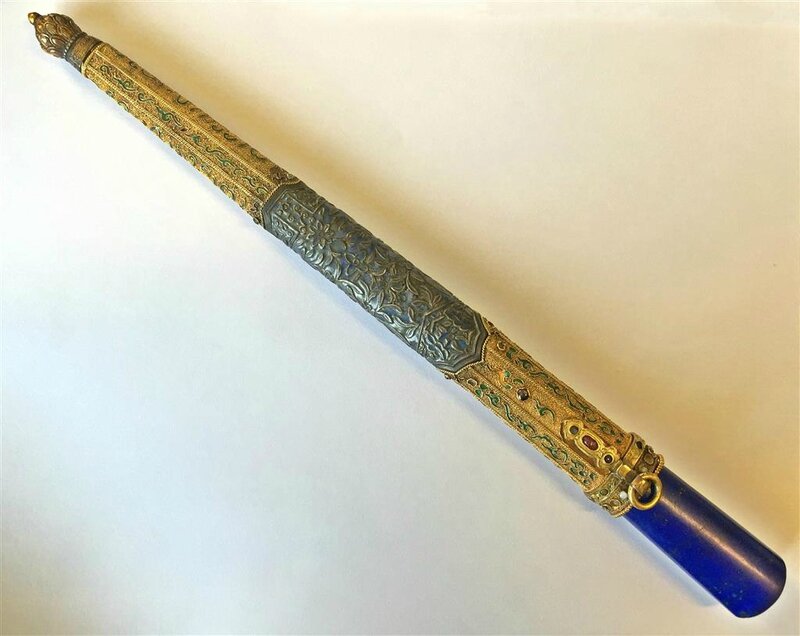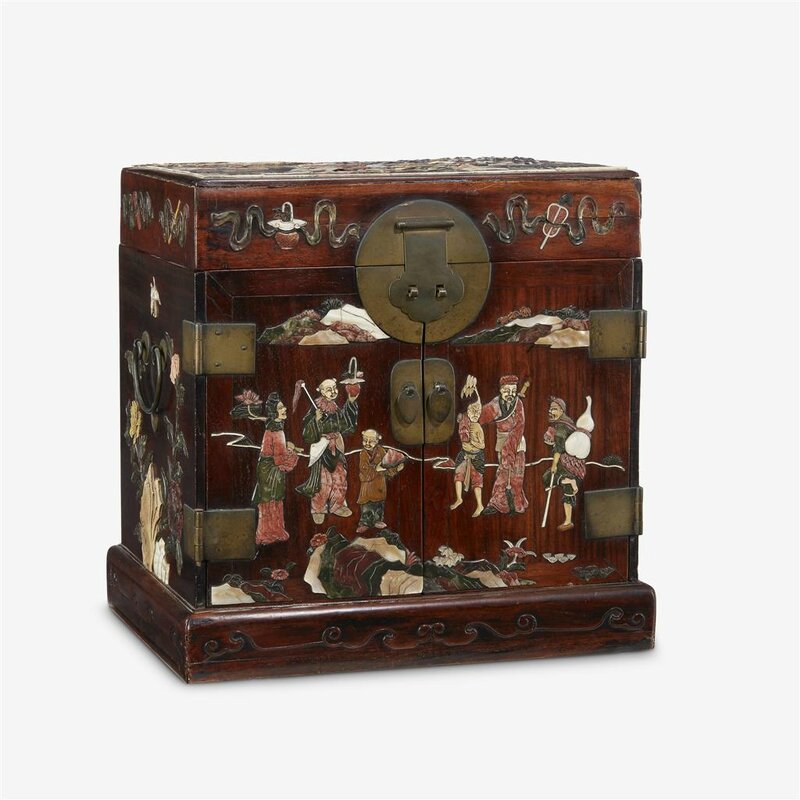Freeman's begins fall auction season with Asian arts sale on September 10
PHILADELPHIA, PA.- Freeman's will kick off its fall auction season with Asian Arts on September 10. Boasting an eclectic assemblage of Chinese and East Asian art ranging from China’s bronze age into the 21st century, this sale coincides with Asia Week New York, which starts on September 9. Featured in the auction are a rare Imperial Chinese hunting knife with enameled gold and silver sheath of the Qianlong period, an important Chinese hardstone-embellished huanghuali seal chest, and a rare Chinese cloisonné enamel square form censer and cover bearing the Jingtai six character mark.
Lot 86 is a rare Imperial Chinese hunting knife, crafted for use as part of the imperial courtly costume. Such knives were a symbol of Manchu ruggedness and self-reliance, added to formal regalia to set themselves apart from their Ming predecessors, who did not cut their own meat. The hunting knife embodied the independent spirit of the Manchu a throwback to their nomadic past. Even the women of the court carried such knives. Few knives of this type have appeared at auction, in fact Asian Arts department head Richard Cervantes remarks that that the example going up for auction on September 10 is the most formal in style he has ever seen offered. It a particularly rare configuration among known Qianlong Imperial hunting knives in that the sheath tapers to a point and the handle is composed of two materials -vibrant blue lapis lazuli and a "hidden" section of white jade only revealed when the knife is unsheathed. It is estimated at $20,000-40,000.
Lot 86. A rare Imperial Chinese hunting knife with enameled gold and silver sheath, Qianlong four character mark and of the period (1736-1795). Estimate $20,000-40,000. Photo Freeman's
the two-part handle contstructed of lapis lazuli and pure white nephrite capped with a bead inset gold band, the gilded steel blade inset to spine with gold wire Qianlong Nianzhi mark, the unusual tapering sheath decorated with a shaped band of blue enameled repoussé silver between sections of beaded and enameled gold filigree, the tip of the sheath decorated with gilt copper lotus bud. Overall L: 12 1/4 in., 31 cm
Provenance: Property of a Pennsylvania Gentleman
Acquired by American world traveler and collector in early 20th century, thence by descent
Note: Few Imperial hunting knives of the Qing Dynasty bearing four-character reign marks have appeared at auction within the past ten years. A marked Qianlong hunting knife with carved rhinoceros horn sheath and antelope horn handle was sold as Lot 1817 from Sotheby's Hong Kong 's October 8, 2009 auction of imperial artworks from the celebrated Water, Pine and Stone Retreat. The next year, Sotheby's Hong Kong's April 8 auction of Fine Chinese Ceramics and Works of Art featured Lot 1810, a marked Qianlong hunting knife with horn handle and a gold and turquoise sheath. Freeman's Lot 86 appears a particularly rare configuration among known Qianlong Imperial hunting knives in that the sheath tapers to a point and the handle is composed of two materials -vibrant blue lapis lazuli and a "hidden" section of white jade only revealed when the knife is unsheathed. A single knife of similar form with a jade handle and tapering sheath terminating in a gilt bronze lotus bud is part of the Metropolitan Museum of Art's permanent collection, a gift of Heber R. Bishop, 1902 (accession number 02.18.736a, b).
Such knives were a symbol of Manchu ruggedness and self-reliance. Whereas the aforementioned knives composed largely of organic materials evoke rustic survival, though, our Lot 86 speaks more of formality within Qianlong's court. Its lapis, jade, jewel, gold, silver, steel, bronze and enamel makeup indicate strict ceremonial use.
Inlaid chests like Lot 12, estimated at $150,000 to 250,000 and pictured left, are rarely seen at auction. Because of the glue used to hold the shell and hardstone embellishments to the wood, many pieces of this style lose their decoration over time. To have one largely intact after hundreds of years is extraordinary. Even more remarkable is the chest's provenance. Formerly of the Harry Lawrence Collection, this hardstone-embellished huanghuali seal chest was purchased from the Seaholm Collection, and reputedly acquired from Puyi, The Xuantong Emperor, while ruler of Manchukuo (circa 1935-1945). Puyi (also known as the Last Emperor of China) was believed to have often made such sales of imperial treasures to Western collectors during this time period. In need of money, the puppet emperor used his access to the court's stores of such rare and beautiful items to as a source of income.
Lot 12. An important Chinese hardstone-embellished huanghuali seal chest, guanpixiang, Qing dynasty. Estimate $150,000-250,000. Photo Freeman's
large and of traditional square form, the top inset with shell and hardstones to show three noblemen hunting geese through rocky terrain, similarly decorated to front panels and sides with immortals and peonies, five interior drawers and with carved base. H: 15 3/4 in., 40 cm
Provenance: Formerly of the Harry Lawrence Collection, Laguna Beach, California, purchased from the Seaholm Collection, San Diego, California, reputedly acquired from Puyi, The Xuantong Emperor, while ruler of Manchukuo (circa 1935-1945)
Another pieces featured in Freeman's Asian Arts auction is Lot 80, a fine, complete and exceptionally rare cloisonné and gilt bronze square-form censer, estimated at $10,000-15,000. The applied cloisonné enamel to the walls, handles and legs demonstrate the traditional Ming style, incorporating vividly-colored archaistic motifs against the indispensable “Jingtailan” blue ground, pictured left. On the censer’s base is seen a six-character "Da Ming Jingtai Nian Zhi” reign mark, “Made in the period of the Great Ming (Emperor) Jingtai." This particular censer is extraordinary due to its remarkable condition. Despite one minor flaw, the piece remains largely intact. This is a rare find due to the delicacy of the censer's design, the intricacy of the enamel work, and age. The form, condition, and design make Lot 80 an outstanding example of China's golden age of cloisonné.
Lot 80. A fine and rare Chinese cloisonné enamel square form censer and cover, fangding, Jingtai six character mark, 16th-17th century. Estimate $150,000-250,000. Photo Freeman's
of archaistic form, the rectangular-sectioned body brightly enamelled in blue, yellow, white and red with abstract taotie masks design and various auspicious emblems, each side bordered and centred with a vertical gilt flange, the reticulated gilt and cloisonné enameled cover with kuilong and clouds surmounted by a stylized dragon, all raised on four similarly cloisonné-enameled high splayed legs.
H: 14 1/2 in., 37 cm
Provenance: Property from a Philadelphia estate
Note: For a 16th century censer of dissimilar body form but with comparable archaistic reticulated gilt bronze vent and finial see Sotheby's Paris Lot 42, June 23, 2016

/https%3A%2F%2Fprofilepics.canalblog.com%2Fprofilepics%2F1%2F0%2F100183.jpg)
/https%3A%2F%2Fstorage.canalblog.com%2F03%2F02%2F119589%2F96711876_o.jpg)
/https%3A%2F%2Fstorage.canalblog.com%2F11%2F31%2F119589%2F94773502_o.jpg)
/https%3A%2F%2Fstorage.canalblog.com%2F20%2F83%2F119589%2F94772815_o.jpg)
/https%3A%2F%2Fstorage.canalblog.com%2F26%2F72%2F119589%2F75604929_o.jpg)
/https%3A%2F%2Fstorage.canalblog.com%2F59%2F60%2F119589%2F26458628_o.jpg)












/image%2F1371349%2F20240416%2Fob_65a1d8_telechargement-31.jpg)
/image%2F1371349%2F20240331%2Fob_7209d9_117-1.jpg)
/image%2F1371349%2F20240324%2Fob_64049b_1.jpg)
/image%2F1371349%2F20240324%2Fob_a0994e_1.jpg)